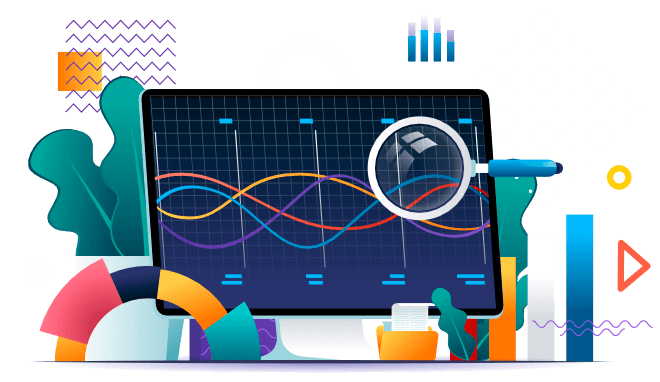
The accuracy of your sales forecast is almost as important as your revenue target. How do you know which sales forecasting method will provide you with the most accurate results? You can accurately predict future revenue by choosing the right forecasting technique. We'll discuss effective sales forecasting methods in this post.
What is a Sales Forecast?
An estimate of sales revenue is called a sales forecast. In a sales forecast, you estimate how much your company will sell within a certain time period (such as a quarter or a year). The best sales forecasts achieve this with high accuracy. Inputs for sales forecasts vary; for example, they may rely on sales reps' intuition or even artificial intelligence (AI). However, all sales forecasts answer two key questions:
How much: There is a projected amount that each sales opportunity will bring into the business. Each new business must be represented by one number, whether it's $500 or $5 million. In order to create the number, they take into account everything they know about the prospect.
When: The sales team forecasts the revenue for a particular month, quarter, or year.
It's not easy to come up with those two projections. To make forecasts, sales teams consider who, what, where, why, and how:
Who: Forecasts are made by sales teams based on who their prospects are. Forecasts will vary depending on whether the prospects are decision-makers or just influencers.
What: Forecasts should be based on the exact solutions you plan to sell. It should be based on problems your prospects have raised, which your company can solve in a unique way.
Where: Where are buying decisions made, and where will products be used? When sales teams visit the center of the action (at least for a visit), they see more accuracy.
Why: What motivates your prospect or existing customer to consider new services from your company? Is there a compelling event that makes them consider it now? Deals stall inevitably without a forcing function and a clear why.
How: In what ways does this prospect tend to make purchasing decisions? In your forecast, if you don't account for how they do it now and how they've done it in the past, it may be fuzzy.
Several of these elements are based on real facts, while others are conjectures. As you sell more, you become better at forecasting. Because of this, sales forecasting is both an art and a science.
Why is Sales Forecasting Important?
Think about two examples: one involving a car manufacturer and another involving an e-commerce store to understand why sales forecasting is so important. A car manufacturer takes a long time to build a car. In order to ensure the number of cars available for purchase meets demand, the manufacturer has a complex supply chain. No matter where you buy something online, whether it's from a large marketplace or a small boutique, you get a delivery estimate. Deliveries that arrive a day or a week late will affect your satisfaction with the company - and your willingness to do business with them again.
In both cases, sales forecasting is similar. Forecasts help businesses plan resources for shipping products, paying for marketing, hiring employees, and more. An accurate sales forecast leads to a well-oiled machine that meets customer demand today and in the future. As with a timely shipment, on-time sales revenue keeps leaders and collaborators happy on sales teams.
The company faces challenges if forecasts are off, which affects everything from pricing to product delivery. Furthermore, if forecasts are accurate, the company may be able to make better investments, such as hiring 20 new developers instead of 10 or opening a new sales office in a prime location.

Who is Responsible for Sales Forecast?
Each organization has a sales forecast owner. The following teams are usually responsible for the following:
Product leaders: A timeline was set for when products would be available for sale.
Sales leaders: Their teams promise to deliver the numbers they promise. Leaders forecast differently depending on their seniority. A first-line manager forecasts collections of opportunities, while a third-line manager considers a wide range of numbers and traditional close rates.
Sales reps: Managers receive their own numbers from the employees.
What are the Objectives of Sales Forecasting?
The purpose of sales forecasting is to paint an accurate picture of expected sales. It is the goal of sales teams to either hit or exceed their expected targets. When sales forecasts are accurate, operations run smoothly, and leaders are pleased with the plan's execution. Everyone is happier when the company exceeds its forecast and decides how it will invest the extra money. However, if your forecast is consistently wrong, you should adjust it.
Besides accuracy, sales teams hope their forecasts will contribute to smooth internal and external operations.
The friction inside the organization - about all things revenue funds - melts away when the forecast is met. It is not necessary to make trade-offs and compromises when it comes to things like cutting the workforce, reducing support, or halting product development. Business is humming along nicely instead.
External operations that are smooth: Every company wants to delight its customers and partners. If forecasts are met, and internal operations are flowing smoothly, your company can continue funding external marketing events, staffing plenty of customer service touchpoints, and investing in its community. Everything inside appears to be working as it should from the outside. You'll notice a different (not so good) feeling in the hallways at work when your sales forecast is on the downside, as opposed to accurate or even positive. Keeping morale and collaboration high is your goal.
Techniques for Sales Forecasting
Forecasting relies on data requirements and the application of the data to project future sales. Sales forecasts are only as good as the data they are based on. There are three types of sales forecasting techniques used by forecasting specialists. Forecasting demand is based on the input data used. Forecasting demand is based on the input data used. Forecasting techniques include qualitative techniques, time series analysis, and causal projection models.
Qualitative analysis uses qualitative data, while time series analysis focuses on patterns and changes in patterns. Relationships between system elements are highly refined and specific in the causal model. Due to the variance in the techniques, the same type of technique cannot be used to forecast sales. Using time series analysis that relies on historical data may not be able to forecast the future of a new product without a history. What are the general functions of the three types of sales forecasting techniques?
Qualitative Techniques
When there is limited data available, qualitative forecasting techniques are used. When you introduce a new product to the market, you can use qualitative techniques. Forecasting the future of the product is difficult due to a lack of data. To convert qualitative information into quantitative estimates, the techniques use human judgment and rating schemes.
This method aims to bring together logically and systematically all judgments and information regarding the factors being estimated. When penetration rates and market acceptance of a product are uncertain, qualitative techniques can be used. They can also be used in new technology areas where several inventions are required to develop a product.
Time Series Analysis
When you have years of data about a product or product line, you can use Time Series analysis to forecast sales. When you have stable trends and relationships about a product, you can use it as well. Using past performance data, the forecaster determines the current performance rate and the change in performance rate. Forecasting is based on the acceleration or deceleration of current rates. Raw data are arranged chronologically in a time-series method. Time-series analysis explains:
● Trends in the data
● Cyclical performance patterns that repeat any two or three years
● Any systematic variation or regularity of data in different seasons
● Growth rates of various trends in data

Casual Models
A causal sales forecasting model can be developed when you have enough historical data about a product. The analysis should include the factors you wish to forecast as well as other economic and socioeconomic factors. Use the causal model if you want sophisticated sales and forecasting models. The causal relationship is expressed, as well as market survey information and other considerations. Time series analysis can also be incorporated into the technique. Promotions and strikes are predicted based on the dynamics of the flow system.
Ways to Build Accurate Forecasting
There are different methods for forecasting sales. These are some of the most common ways to forecast sales. To further illustrate each method of sales forecasting, we have included some examples.
Opportunity Stage Forecasting
Opportunity stage sales forecasting for the various stages of the sales process. A deal is more likely to close the further along it is in the pipeline. If you choose a reporting period - usually month, quarter, or year, depending on how long your sales cycle is and your sales team's quote - you simply multiply each deal's potential value by its probability of closing.
Once you've done this for each deal in the pipeline, add up the total to get your overall forecast. It is relatively easy to create a sales forecast this way, but the results are often inaccurate. An opportunity's age is not taken into account in this method. A deal that's been in your rep's pipeline for three months will be treated the same as the one that's a week old, so long as their close dates are the same. The problem is that you have to trust your salespeople to regularly clean up their pipelines, which isn't always possible.
It is also possible for an opportunity stage sales forecast to rely too heavily on historical data. Your deals will lose at different percentages by stage if you change your messaging, products, sales process, or any other variable.
Length of Sales Cycle Forecasting
Using the age of individual opportunities, the length of the sales cycle forecast is calculated. You're less likely to get an overly generous prediction with this technique because it relies solely on objective data rather than the rep's feedback. Let's say salesperson schedules a demo with a prospect before they're ready. Even if they tell you the prospect is close to buying, this method calculates they're unlikely to buy since they only started talking to the salesperson a few weeks ago.
Additionally, this technique can be applied to different sales cycles. A normal lead might take roughly six months to buy, but leads from referrals could typically take one month, and leads from trade shows might take eight months. The average sales cycle length can be used to bucket each deal type. Track how and when prospects enter your salespeople's pipelines to get accurate results. Unless your CRM integrates with your marketing software and automatically logs interactions, your reps will spend a lot of time manually entering information.

Historical Forecasting
Looking at the matching time period is a quick way to predict how much you'll sell in a month, quarter, or year. The forecast is based on historical sales data. This method has a few drawbacks. The first problem is that it doesn't account for seasonality. The second assumption is that buyer demand is constant. You won't be able to use your model if anything unusual happens. In the end, historical demand should be used as a benchmark rather than as a basis for your sales forecast.
Bottom Line
Forecasting sales is a crucial aspect of the business. Business leaders can make better decisions about things like goal-setting, budgeting, hiring, and other aspects that affect cash flow if they have accurate sales forecasts. A poor sales forecast leaves sales managers guessing whether they'll meet the quota. Therefore, they may not be aware of any problems in their sales pipeline in time to fix them.
Universal Creative Solutions offers business consulting to help you derive the right method tailored to your situation. With the right forecasting method, you can accurately allocate resources and help make strategic business decisions that will grow your organization.

